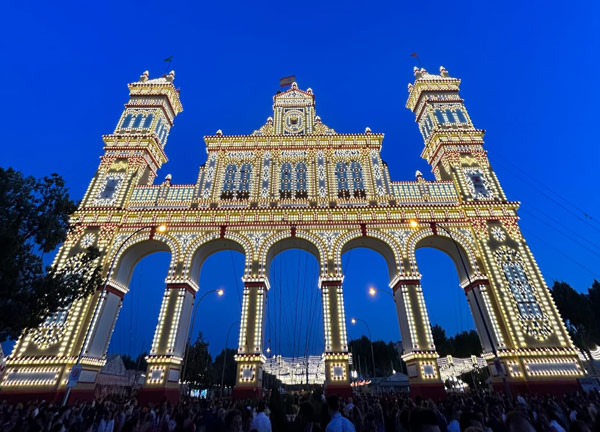Feria de Abril: A Study Abroad Guide to Extravagance at a Student “Fare”
THE BASICS
Two weeks after the weeklong Semana Santa processions line Sevilla’s streets, the city transforms again for a festival you simply can’t miss if you’re studying abroad in Seville. The erupting colors of spring collide with the bright energy Sevillanos bring to the neighborhood of Los Remedios in a celebration of community with dancing, singing, drinking, and eating in the company of friends and family for Feria de Abril.
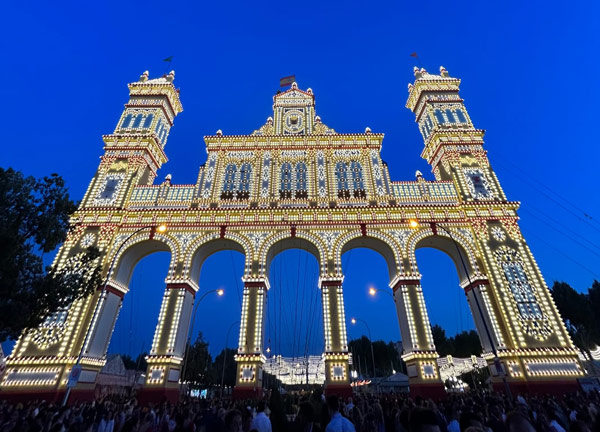
The “Portada” during Feria de Abril, 2023.
In Spring ‘23, the festivities officially began at 12 a.m. on Sunday, April 23. In the hours that led up to the lighting of the “Portada” (entry gate) at midnight, people were already enjoying themselves inside the casetas for “La Noche del Pescaito” (the night of fried fish). The Portada is designed differently each year, and the intricate design was impressive to see firsthand. Casetas are tent-looking structures lining the blocks of the fair. Most of them are private - meaning you must have an invitation from someone inside or be a member of a particular company, club, or organization allowing guests. Otherwise, there are also some public casetas that are accessible throughout the week, also offering celebrations. I must say - simply being in the surrounding area is a treat, to see people all dressed up with one another.
During La Noche del Pescaito, I walked aimlessly through the streets, which held over 1,000 casetas, casually glancing in to see people eating their dinners at elaborate dining room tables decorated to the extreme with paintings on the temporary walls. Feria also marks the start of the bullfighting season, so representations associated with bullfighting, like paintings in the casetas were also commonplace. I was told before that people went all out and in some cases, supposedly took out loans to be able to participate. I was in awe at the extensive nature of it all.
On one half of the grounds, there are casetas, lining the streets named after popular bullfighters, while the other half is an amusement park. It was interesting to see a hybrid between the concept of fairs that I am familiar with from previously attending state fairs, with rides and games, yet, in Sevilla, with people dressed in fancy clothing. It was surreal in some moments, and I felt like I was walking through a movie set.
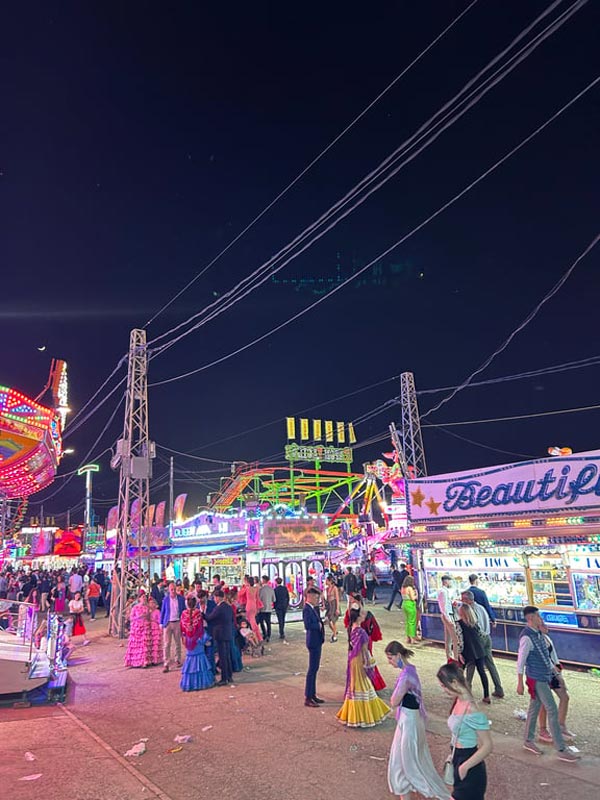
A glimpse into the amusement park of Feria. People go on the rides in their outfits, and while children also participate in the casetas, they are also found enjoying the rides in this section of the festival.
After the lighting of the Portada, the festival is officially in motion until the following weekend. Throughout the week, most people attend later in the afternoon or evening and stay through the night until the following morning before going home to rest before going all over again later that night! Provided the extreme heat which already surpassed 90 degrees Fahrenheit, it is not a surprise this is the most typical schedule people follow. I did not last until 6 or 7 a.m., but it was still incredible to be amidst the radiant, happy energy of attendees.
WHAT TO WEAR
First, do yourself a favor and wear comfortable shoes. I saw far too many people shuffling by in heels that undoubtedly gave them blisters, sometimes even resorting to barefoot and carrying their shoes separately. In my case, I wore a pair of black boots which certainly didn’t meet Sevillian style standards. However, it didn’t matter because my dress skirt covered them (so hush - no one knew, anyways!). While they didn’t match perfectly, my feet were comfortable since they were most supportive, and I knew I could easily clean the sandy dust off afterward.
Now, beyond the feet, most people will wear a “traje de flamenco” (flamenco dress), or a suit and tie with dress shoes. If you prefer a more modern twist on the dress, it is also acceptable to wear a nicer outfit - perhaps a springy dress or jumpsuit. When I first arrived to study abroad in January, there was some chatter about the importance of securing a dress for Feria early on because they’re made to order - and at a pretty penny! Most dresses cost north of 500 - 700 euros, which is expensive, and simply not something I budgeted for
As I developed a relationship with my host mom, I felt comfortable asking her for recommendations as to where to either buy one inexpensively or potentially find a shop to rent one at. In Spanish culture, there’s the concept of having “enchufe,” which means that you have connections with people who can help you be successful, maybe get a job, or participate in particular activities. Luckily, I had “enchufe” as my house mom said she’d talk to some of her friends to see if I could try to rent one from them. I was thrilled and hopeful something would work out.

As you can see here, it is traditional for hair to be pulled back out of the face and with the flower placed on the top of the head. I was ecstatic to dress up and participate in Feria de Abril. It was truly the epitome of Sevillan charm, culture, and community.
Luckily the dress I tried on fit, and our house mom even had “los complementos” (accessories) to complete our looks! In contrast to the hundreds of euros, we only had to pay 35 euros to rent a dress from her friends. Despite Feria being a festival of extravagance, even on a student’s budget, participating is manageable. I’m incredibly grateful for our house mom’s assistance in acquiring the proper style, as it made getting ready for, walking to, and participating in Feria an incredibly memorable experience.
SOME INSIGHTS & TIPS
In preparation for your first Feria, there are some things to know in advance…
First of all, if you really want to get your own dress, from what I heard, this is something you want to get fitted for in January - well before April to ensure it is ready in time. Although bear in mind if you buy it, you must find a way to transport it home. Considering how large (and heavy) the dresses are, you’ll likely incur another cost. I know plenty of people who rented or bought their dresses second hand at a much more reasonable price. I even know some people who shared the same dress by attending Feria on different days to help save money. A few of the shops I heard about are the following to get you started, although I’m sure there are many more: Miel de Mariposa, Humana, and Pau 39.
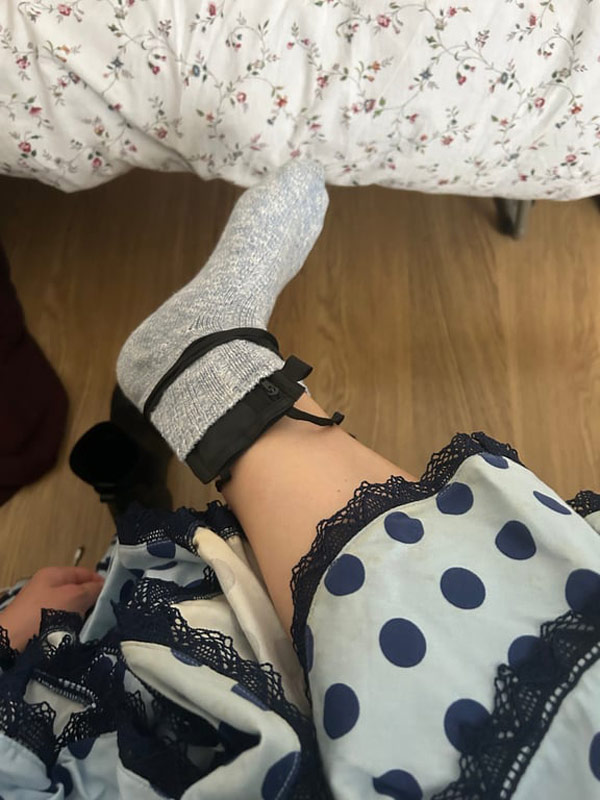
You’re probably wondering why you are staring at a photo of my sock right now - but with good reason! I managed to wrap a coin purse around my ankle and fit it inside my boot to carry my essentials - card, cash, keys, and ID. Many of the dresses or skirts have pockets hidden in them. However, I could not find one in mine, so this was the next best option!
Something I wish I pursued earlier, is attending Sevillanas classes. Some of my friends in the program attended Sevillanas class one evening a week in the weeks leading up to Feria for 10 euros/session. They enjoyed their experience as it gave them the tools to participate in the dances and feel more connected to people at Feria. If you don’t wish to commit to a repeating class, CEA CAPA offered one free lesson in the center’s courtyard one evening, which I highly encourage you to attend! For me, it was especially special since my host mom happened to be the instructor. It was an evening of dancing, music, and laughter as we all tried our best to master the sequence, and it was a great way to at least be exposed to the style before Feria.
IN THE MOMENT
People-watching is one of my favorite activities, and this was no different during my time at Feria. When my friend and I left to walk from the city center to Los Remedios at around 6 p.m., people gave us stares as we sported our Feria looks. Upon arrival, we walked around the streets briefly before entering a public caseta where we treated ourselves to a refreshing pitcher of rebujito. Rebujito is a typical beverage enjoyed during Feria, consisting of sherry and 7up, and it even originated in Andalucia! We made a point of eating before going to save money on the expensive food prices, although you can certainly order tapas in the casetas, too. The entire caseta was full of people - standing at the bar, dancing with one another, or sitting around tables while eating or drinking. Talk about a city-wide party!
Eventually, we scored ourselves some seats along the side of the caseta, from which it was a treat to sit, and people-watch, sip on our rebujito, and cool down while taking in all of the warm energy and happiness radiating from the caseta, and pouring into the streets. As the sun began to set, more people arrived, and the streets seemed to glow even more.
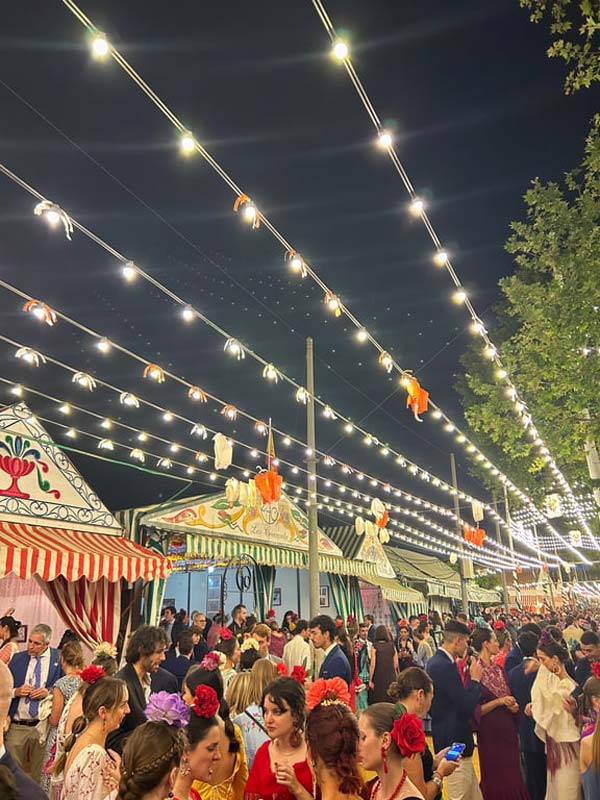
People enthusiastically socializing both inside and out of the casetas. Study abroad in Sevilla during the spring to feel the energy, yourself!
Feria de Abril is a weeklong festival, and while many Sevillanos may attend every day, unless you want to, you don’t need to go daily. Without a doubt, the week presents a phenomenal opportunity to take advantage of the break from school and travel to explore a new area, too. If you wish to travel elsewhere, you should. However, do not neglect some immersion in one of the most important festivals in Spain. People come to Sevilla to experience Feria de Abril, and you may be privileged enough to live there while it happens. So, prepare yourself and “tener emocionada” (get excited!), because Feria de Abril is unlike anything you’ve ever experienced!









